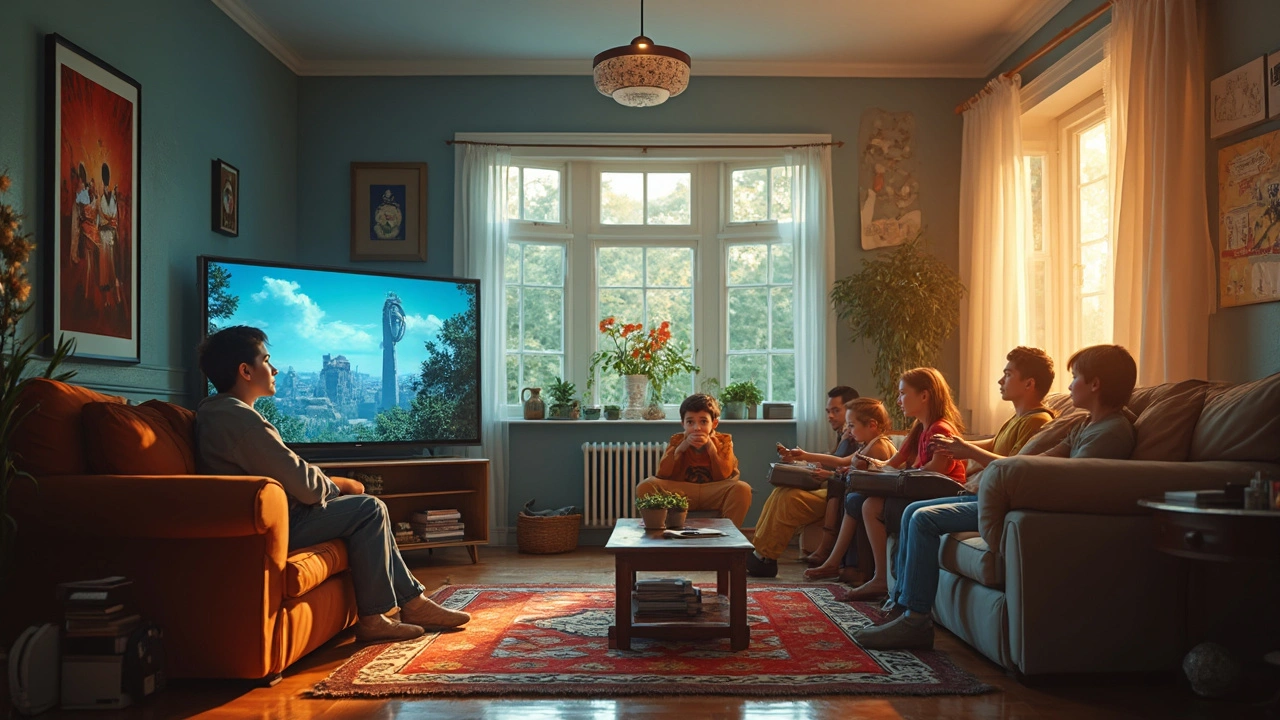Imagine your brand popping up in the middle of someone's favorite game—not as an annoying pop-up, but something that feels like it actually belongs there. That’s the power of in-game ads done right. Games aren’t just for teens in basements anymore; adults spend hours playing on their phones, consoles, and PCs. In 2024, the global gaming audience crossed the 3.3 billion mark. That's one massive crowd you don't want to ignore.
What makes gamified ads special is how personal and immersive they can be. Instead of begging for attention on the sidelines, your brand can actually be part of the virtual world players are engaging with. A branded car speeding by in a racing game, a digital billboard in a soccer stadium, or a drink your avatar sips at halftime—it all just fits.
- Why Gaming Is the New Ad Frontier
- What Makes An In-Game Ad Effective
- Tips for Creating Non-Intrusive Campaigns
- Measuring Success: Analytics That Matter
Why Gaming Is the New Ad Frontier
The days when gaming was just a niche hobby are long gone. Right now, in-game ads are one of the best ways for brands to get noticed by a huge, diverse crowd. Nearly half the world’s population plays games, with gamers spread out across every age group and background. In 2024, the gaming industry racked up over $184 billion in global revenue—not counting extra money from the ads themselves.
Mobile gaming has blown up even faster than console or PC gaming. Think about this: 64% of American adults play games on their smartphones, usually squeezing in quick sessions between other activities. That means there are millions of chances a day to put your brand in front of the right eyes—all while someone is having fun and actually paying attention.
Why are in-game ads so effective compared to traditional digital advertising? Unlike banners that get ignored or skipped, ads in games blend into the action. Players might not mind—or even notice—they’re being advertised to when it fits naturally with the game. In fact, brands that go for authentic placements see much higher engagement. A 2023 survey by Newzoo showed nearly 38% of gamers remembered brands seen inside their favorite games, while less than 15% recalled traditional banner ads.
| Platform | Active Players (2024, Billions) | Avg. Session Length (Minutes) |
|---|---|---|
| Mobile | 2.7 | 23 |
| Console | 0.58 | 42 |
| PC | 0.55 | 50 |
So, getting your brand reach into the world of gaming isn’t just smart—it’s basically essential if you want to keep up. It’s where attention is shifting and where people are spending time willingly. If you’re still pouring all your digital spend into social or search, you’re missing out on a huge part of the action.
What Makes An In-Game Ad Effective
A good in-game ad blends into the game’s world, so it feels natural to the player. No one wants to see random banner pop-ups when they're about to make a high score. The ad should fit where it appears, like a real-life brand you'd see in a sports arena or on a race car. When it looks and feels like it belongs, players pay more attention—research from the IAB in 2023 found that in-game ads with natural placement boosted brand recall by 28% over standard display ads.
Another thing that matters is the ad's relevance. If your brand targets families, you probably don’t want your ad showing up in a dark, horror-themed game. Match the vibe of the game and its audience. Brands that do this right see way better results, and players are less likely to get annoyed or tune out.
Timing also plays a big part. Ads that pop up during loading screens, replays, or short breaks don't yank the player out of the action. That keeps people engaged with your brand without ruining their fun. Some games go even further and let players unlock perks for checking out an ad, which actually makes players want to see your message.
- Immersive integration: Use in-game objects, billboards, or scenery.
- Clear, readable design: Players only look for a split second, so simple graphics and bold logos work best.
- Right timing: Place ads during natural pauses, like halftime or between levels.
- Consistent message: Don’t disrupt the story or game flow with something off-topic.
For even more perspective, check out how different ad formats stack up:
| Ad Format | Average Viewability | Player Recall Rate |
|---|---|---|
| In-Game Billboard | 95% | 32% |
| Rewarded Video | 88% | 46% |
| Loading Screen Ad | 72% | 22% |
The bottom line? When in-game ads look and feel like part of the game, and show up at the right moment, players notice your brand—and actually remember it.

Tips for Creating Non-Intrusive Campaigns
The biggest mistake brands make with in-game ads is shoving logos or banners right in players’ faces. Nobody likes having their game interrupted by a loud message about shoes or energy drinks. If you want your brand reach to soar, your ads need to blend in but still catch the eye.
The golden rule? Make your ad feel like a natural part of the game world. Here's what that actually looks like:
- Native Integration: Don’t just stick your ad on the loading screen. Put it where it makes sense—in the game’s environment, on in-game billboards, jerseys, or product placements. For example, sports games thrive with real brands on digital signage and stadiums, just like real life.
- Reward-Based Ads: Studies from IAB Europe show that rewarded ads—like watching a quick video for extra lives or power-ups—boost engagement rates up to 3x compared to forced pop-ups. Players see value, which makes them less likely to get annoyed.
- Skippable Content: Always give players a choice. Skippable ads are less frustrating, and according to GameRefinery, brands using skippable formats see higher favorability ratings from gamers.
- Stay Subtle, Stay Relevant: Try dynamic ads that change depending on what’s happening in the game. A soda ad during halftime? Makes sense. Pizza ad after a game win? Even better. Keep it relevant and it won’t break the immersion.
Let’s look at some recent numbers that prove why subtlety pays off:
| Ad Format | Player Approval (%) | Engagement Boost (%) |
|---|---|---|
| Native product placements | 74 | 12 |
| Reward-based ads | 81 | 22 |
| Banner pop-ups | 32 | 3 |
At the end of the day, gaming marketing isn’t about yelling louder—it’s about showing up in ways that respect the player’s space. Make it a win-win: boost your digital advertising metrics while keeping the gameplay fun and distraction-free.
Measuring Success: Analytics That Matter
Sure, launching in-game ads sounds cool, but how do you actually know if they’re hitting the mark? Tracking real performance is key. The best brands don’t just toss their logo into a game and hope for the best—they obsess over numbers, and you should too. When it comes to in-game ads, you want to keep an eye on metrics that tell the whole story, not just surface-level vanity numbers.
Start with the basics: impressions show you how many times a player sees your ad. But let’s be real—just being seen doesn’t always mean being noticed. That’s why engagement metrics matter even more. Think clicks, interactions, how long someone views your product, or if they actually mess with your branded item in the game. Some games even let you track things like whether a player completed a branded challenge or redeemed a coupon code.
| Metric | What It Tells You |
|---|---|
| Impressions | How many times your ad was seen |
| Engagement Rate | How many people interacted with your ad |
| Click-through Rate (CTR) | How often viewers clicked your ad from within the game |
| Redemption/Conversion | If players used your offer, code, or visited your site |
What’s really changed in 2025 is that brands can now tap into super-detailed behavior tracking. Games collect reliable, real-time data—so you can stop guessing and actually see what works. A handy tip: look at session length during ad exposure to figure out if folks are hanging around longer because your ad feels fun (not annoying).
Here's something from a source the whole industry watches.
"Precise targeting and detailed measurement are what set in-game ads apart. You're not just measuring clicks, you're seeing a full picture of how gamers interact with your brand inside their world." — Tom Simpson, Group MD, AdColony Asia
Don’t forget A/B testing. Tweak your creative, try new placements, see what grabs players. The strongest campaigns keep testing and learning. And if you really want to see if your brand lift is real, track it before, during, and after the campaign. People might start searching for your brand more, mentioning you in gaming forums, or just talking about your offer in chat. That’s a solid sign your in-game ads are paying off.


I'm Felix Humphries, a seasoned professional in marketing with specialized expertise in online strategies. I foster compelling brand identities and drive growth through effective marketing solutions. I apply a data-driven approach to identify and track marketing trends, fueling impactful strategies. When I'm not strategizing, I enjoy turning my experiences into insightful articles about online marketing.